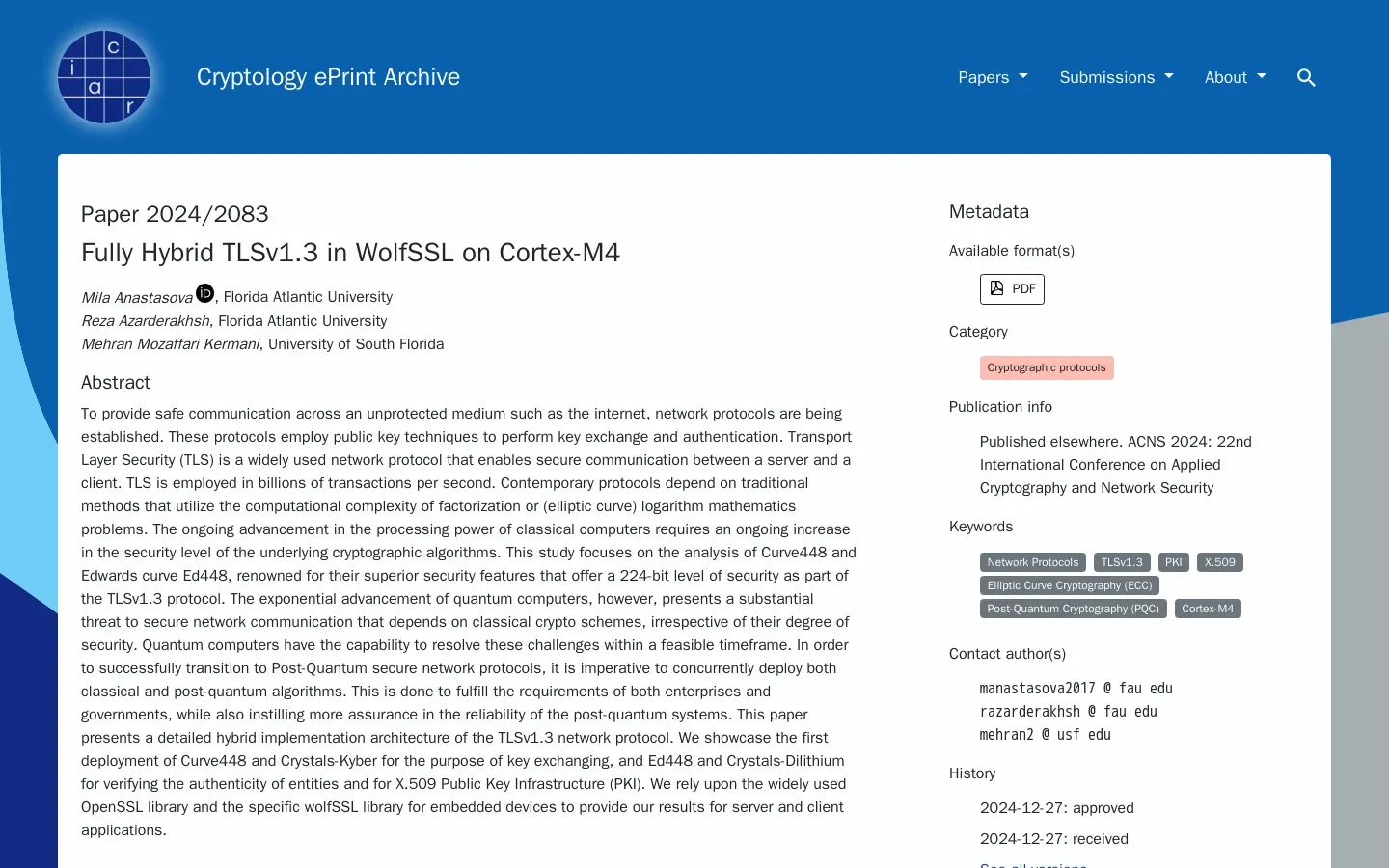
Hybrid TLSv1.3 Protocol Developed for Cortex-M4 Systems
/ 4 min read
Quick take - Recent research on the hybrid TLSv1.3 protocol has introduced a comprehensive approach to secure communications by integrating classical and post-quantum cryptographic algorithms, aiming to enhance cybersecurity, particularly for IoT devices and critical infrastructure, while advocating for standardized compliance frameworks and further exploration in hybrid cryptographic protocols.
Fast Facts
- Hybrid Cryptographic Design: The research introduces a hybrid protocol combining classical and post-quantum cryptographic algorithms to enhance security against quantum threats.
- IoT Security Improvement: The hybrid TLSv1.3 protocol aims to significantly bolster the security of IoT devices, which are often vulnerable to cyberattacks.
- Critical Infrastructure Protection: The protocol is applicable in vital sectors like energy, transportation, and healthcare, emphasizing the need for robust security measures.
- Standardization Advocacy: The study calls for the development of standardized compliance frameworks to guide the implementation of hybrid cryptographic protocols across industries.
- Recommended Tools: The research suggests using advanced cryptographic tools like Curve448, Crystals-Kyber, Ed448, and Crystals-Dilithium to facilitate the hybrid protocol’s implementation.
Advancements in Hybrid Cryptographic Protocols for Secure Communications
In a notable advancement in cybersecurity, recent research has introduced a comprehensive approach to secure communication protocols. Detailed in the paper “Fully Hybrid TLSv1.3 in WolfSSL on Cortex-M4,” this study presents a hybrid cryptographic design that integrates both classical and post-quantum cryptographic algorithms. This development is crucial as it addresses the looming challenges posed by quantum computing, which threatens to undermine current encryption methods.
Research Objectives and Methodology
The research sets forth three primary objectives aimed at enhancing secure communications:
-
Hybrid Cryptographic Design: The core objective is to develop a communication protocol that seamlessly combines traditional and post-quantum cryptographic algorithms. This integration aims to ensure resilience against potential quantum threats, which could compromise existing encryption standards.
-
Library Enhancement and Implementation: A significant focus of the study is ensuring compatibility with existing cryptographic libraries. This step is vital for the widespread adoption and functionality of the hybrid protocol across various platforms.
-
Performance Evaluation on Embedded Systems: The research evaluates the performance of the hybrid protocol specifically on embedded systems like the Cortex-M4. These systems are integral to many Internet of Things (IoT) devices, which often have limited processing capabilities.
Key Findings and Implications
The findings from this research carry profound implications for several sectors, particularly in enhancing IoT device security and protecting critical infrastructure.
IoT Device Security Enhancement
The hybrid TLSv1.3 protocol promises to significantly bolster the security of IoT devices. These devices are frequently targeted by cyberattacks due to their constrained processing power. By integrating robust cryptographic measures, the protocol enhances their defense against such threats.
Standardization and Compliance Frameworks
The study advocates for developing standardized compliance frameworks to guide the implementation of hybrid cryptographic protocols across various industries. Such frameworks are essential for ensuring consistent security measures are adopted universally.
Critical Infrastructure Protection
The research underscores the protocol’s applicability in critical sectors like energy, transportation, and healthcare. In these areas, cyberattacks can have severe consequences, making robust security measures imperative for safeguarding public safety and national security.
Ongoing Research on Hybrid Cryptographic Protocols
The study encourages further exploration into hybrid cryptographic protocols. Continuous research is vital for staying ahead of potential vulnerabilities and threats, ensuring that secure communications remain resilient in an evolving digital landscape.
Recommended Tools and Techniques
To facilitate the implementation of the hybrid TLSv1.3 protocol, several advanced cryptographic tools and frameworks are recommended:
- Curve448: A high-security elliptic curve designed to enhance cryptographic strength.
- Crystals-Kyber: A post-quantum key encapsulation mechanism known for its robust security features.
- Ed448: An elliptic curve signature system offering improved performance and security.
- Crystals-Dilithium: A lattice-based signature scheme providing resilience against quantum attacks.
These tools are integral to implementing a secure hybrid cryptographic framework capable of withstanding future cyber threats.
Next Steps
As cyber threats continue to evolve, integrating advanced cryptographic techniques becomes increasingly important to safeguard sensitive information and critical infrastructure. The findings from this research highlight the necessity of ongoing efforts in developing secure communication protocols that can withstand both current and emerging threats. Future research will be crucial in ensuring the integrity and resilience of secure communications in an increasingly digital world.



